Break in TOYOTA GR86 2022 Owners Manual (in English)
[x] Cancel search | Manufacturer: TOYOTA, Model Year: 2022, Model line: GR86, Model: TOYOTA GR86 2022Pages: 582, PDF Size: 86.38 MB
Page 30 of 582
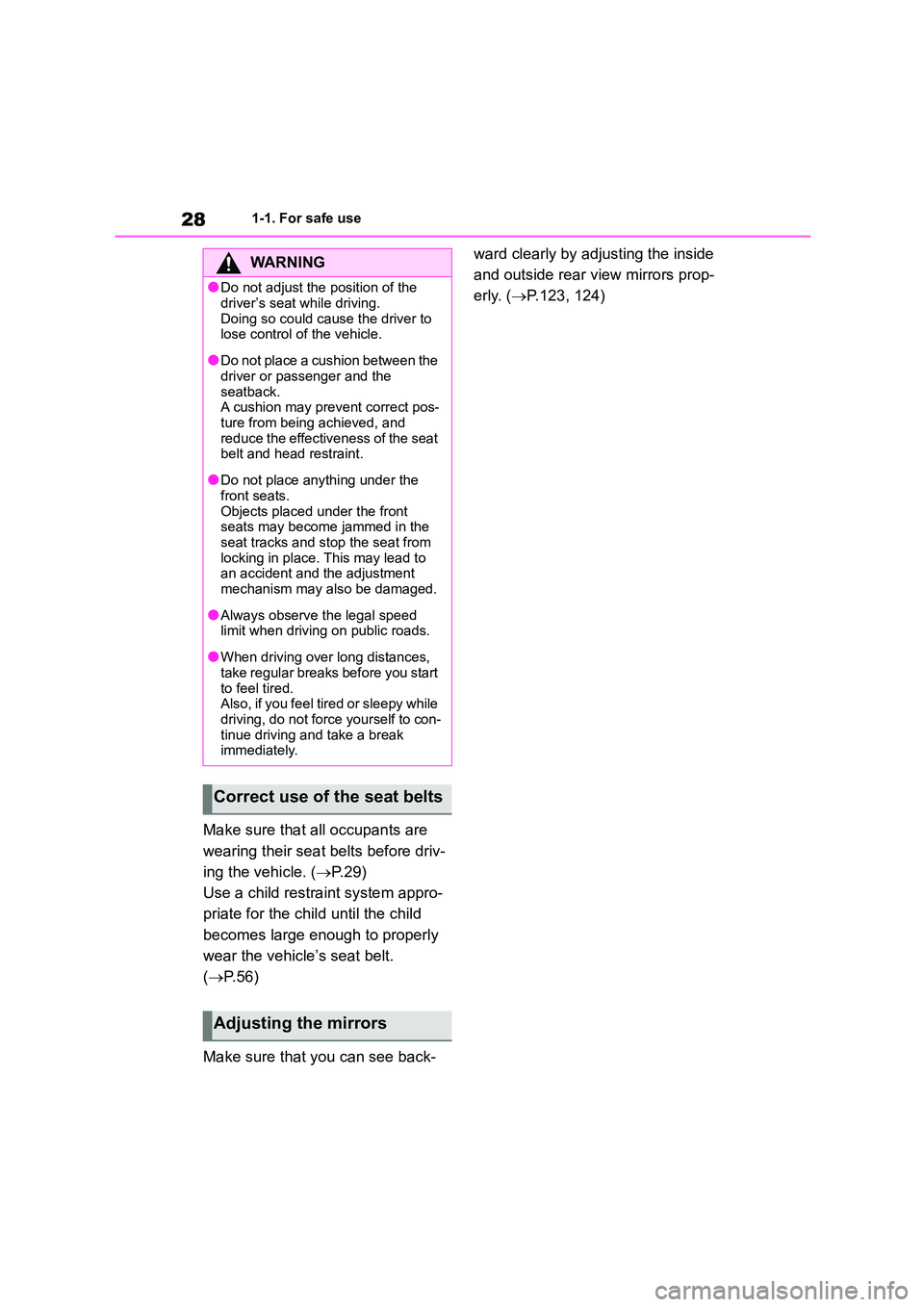
281-1. For safe use
Make sure that all occupants are
wearing their seat belts before driv-
ing the vehicle. ( P. 2 9 )
Use a child restraint system appro-
priate for the child until the child
becomes large enough to properly
wear the vehicle’s seat belt.
( P. 5 6 )
Make sure that you can see back-
ward clearly by adjusting the inside
and outside rear view mirrors prop-
erly. ( P.123, 124)
WA R N I N G
●Do not adjust the position of the
driver’s seat while driving.
Doing so could cause the driver to lose control of the vehicle.
●Do not place a cushion between the driver or passenger and the
seatback.
A cushion may prevent correct pos-
ture from being achieved, and reduce the effectiveness of the seat
belt and head restraint.
●Do not place anything under the
front seats.
Objects placed under the front seats may become jammed in the
seat tracks and stop the seat from
locking in place. This may lead to an accident and the adjustment
mechanism may also be damaged.
●Always observe the legal speed
limit when driving on public roads.
●When driving over long distances,
take regular breaks before you start
to feel tired. Also, if you feel tired or sleepy while
driving, do not force yourself to con-
tinue driving and take a break immediately.
Correct use of the seat belts
Adjusting the mirrors
Page 109 of 582
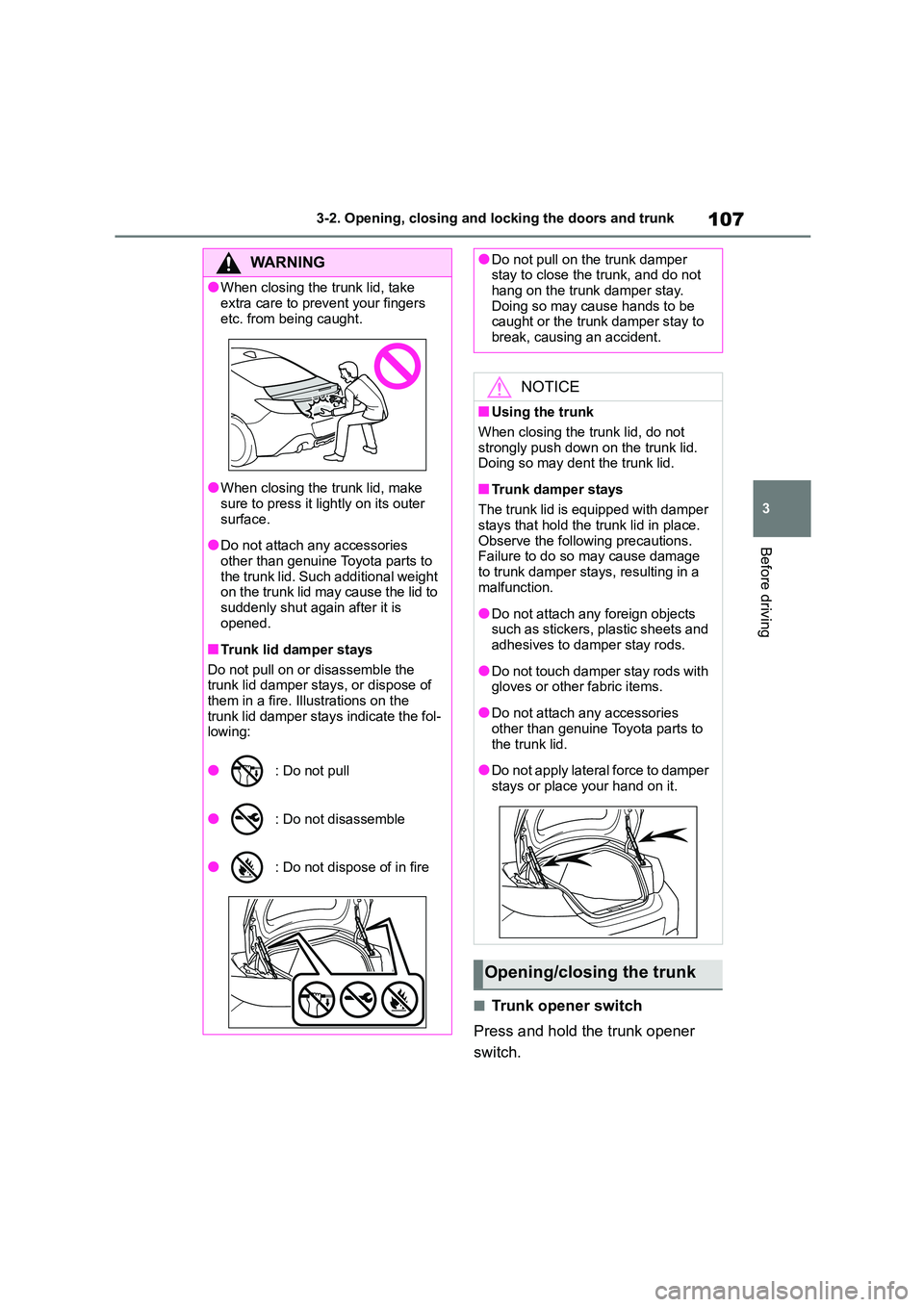
107
3
3-2. Opening, closing and locking the doors and trunk
Before driving
■Trunk opener switch
Press and hold the trunk opener
switch.
WA R N I N G
●When closing the trunk lid, take
extra care to prevent your fingers
etc. from being caught.
●When closing the trunk lid, make
sure to press it lightly on its outer
surface.
●Do not attach any accessories
other than genuine Toyota parts to the trunk lid. Such additional weight
on the trunk lid may cause the lid to
suddenly shut again after it is opened.
■Trunk lid damper stays
Do not pull on or disassemble the
trunk lid damper stays, or dispose of
them in a fire. Illustrations on the trunk lid damper stays indicate the fol-
lowing:
●: Do not pull
●: Do not disassemble
●: Do not dispose of in fire
●Do not pull on the trunk damper stay to close the trunk, and do not
hang on the trunk damper stay.
Doing so may cause hands to be caught or the trunk damper stay to
break, causing an accident.
NOTICE
■Using the trunk
When closing the trunk lid, do not strongly push down on the trunk lid.
Doing so may dent the trunk lid.
■Trunk damper stays
The trunk lid is equipped with damper
stays that hold the trunk lid in place. Observe the following precautions.
Failure to do so may cause damage
to trunk damper stays, resulting in a malfunction.
●Do not attach any foreign objects such as stickers, plastic sheets and
adhesives to damper stay rods.
●Do not touch damper stay rods with
gloves or other fabric items.
●Do not attach any accessories
other than genuine Toyota parts to
the trunk lid.
●Do not apply lateral force to damper
stays or place your hand on it.
Opening/closing the trunk
Page 133 of 582

131
4
4-1. Before driving
Driving
is illuminated.
3 Shift the shift lever to N.
( P.147)
If parking on a hill, shift the shift lever to
1 or R and block the wheels as needed.
4 Press the engine switch to stop
the engine.
5 Slowly release the brake pedal.
6 Lock the door, making sure that
you have the key on your per-
son.
■Starting off on a steep uphill
Automatic transmission
1 Make sure that the parking
brake is set and shift the shift
lever to D.
2 Gently depress the accelerator
pedal.
3 Release the parking brake.
Manual transmission
1 Make sure that the parking
brake is set and shift the shift
lever to 1.
2 Lightly depress the accelerator
pedal at the same time as grad-
ually releasing the clutch pedal.
3 Release the parking brake.
■When starting off on an uphill
The hill-start assist c ontrol will activate.
( P.253)
■Driving in the rain
●Drive carefully when it is raining,
because visibility will be reduced, the windows may become fogged-up, and
the road will be slippery.
●Drive carefully when it starts to rain,
because the road surface will be
especially slippery.
●Refrain from high speeds when driv-
ing on an expressway in the rain, because there may be a layer of water
between the tires and the road sur-
face, preventing the steering and brakes from operating properly.
■Engine speed while driving (vehi-
cles with an automatic transmis-
sion)
In the following conditions, the engine
speed may become high while driving.
This is due to automatic up-shifting con- trol or down-shifting implementation to
meet driving conditions. It does not indi-
cate sudden acceleration.
●The vehicle is judged to be driving
uphill or downhill
●When the accelerator pedal is
released
●When driving on curves
●When the brake pedal is firmly
depressed
■Restraining the engine output
(Brake Override System)
When the accelerator and brake pedals
are depressed at the same time, the
engine output may be restrained.
■New vehicle break-in driving (the first 1600 km [1000 miles])
The performance and long life of your
vehicle are dependent on how you han- dle and care for your vehicle while it is
new. Follow these instructions during
the first 1600 km (1000 miles):
●Do not race the engine. And do not
allow the engine speed to exceed
4000 rpm except in an emergency.
●Do not drive at one constant engine or
vehicle speed for a long time, either fast or slow.
●Avoid starting suddenly and rapid acceleration, except in an emergency.
●Avoid hard braking, except in an emergency.
The same break-in procedures should
Page 218 of 582

2164-5. EyeSight
*: If equipped
●Swaying detection is based on several
minutes of prior driving data. Swaying
will not be detected immediately after the vehicle starts to sway. In addition,
the warning may continue for some
time even after swaying stops.
●Lane Sway Warning is just a function
that warns the driver. When the driver is tired, not concentrating on the road
or not paying adequate attention to
driving, be sure to take rest breaks as often as needed.
●When the Lane Departure Warning OFF indicator is illuminated, Lane
Sway Warning will not operate.
( P.217)
Multimedia system screen
Operate the multimedia system
screen to turn on/off Lane Sway
Warning. ( P.377)
Multi-information display
Also you can turn on/off Lane Sway
Lane Sway War ning*
This function detects swaying
or drifting within a lane, and
warns the driver. When Lane
Sway Warning activates, an
alert sounds 3 short beeps and
an pop-up display will be dis-
played.
This function activates when
the vehicle speed exceeds
approximately 60 km/h (37
mph) and deactivates when the
vehicle speed falls below
approximately 40 km/h (25
mph). The function will reacti-
vate when the vehicle speed is
increased to exceed approxi-
mately 60 km/h (37 mph).
“Stay Alert” A
WA R N I N G
Lane Sway Warning will not operate in all conditions. It also will not auto-
matically correct swaying. If the driver
relies only on Lane Sway Warning to prevent the vehicle from swaying, an
accident may occur.
NOTICE
Under the following conditions, Lane
Sway Warning may not operate.
●On a winding road
●The vehicle speed changes greatly.
●Immediately after a lane change
●It is difficult for the EyeSight stereo camera to detect lane markings.
• There are no lane markings or they
are the very worn.
• The lane markings are yellow.
• The lane markings are similar in
color to the road surface.
• The lane markings are narrow.
Turning on/off Lane Sway
Warning
Page 276 of 582
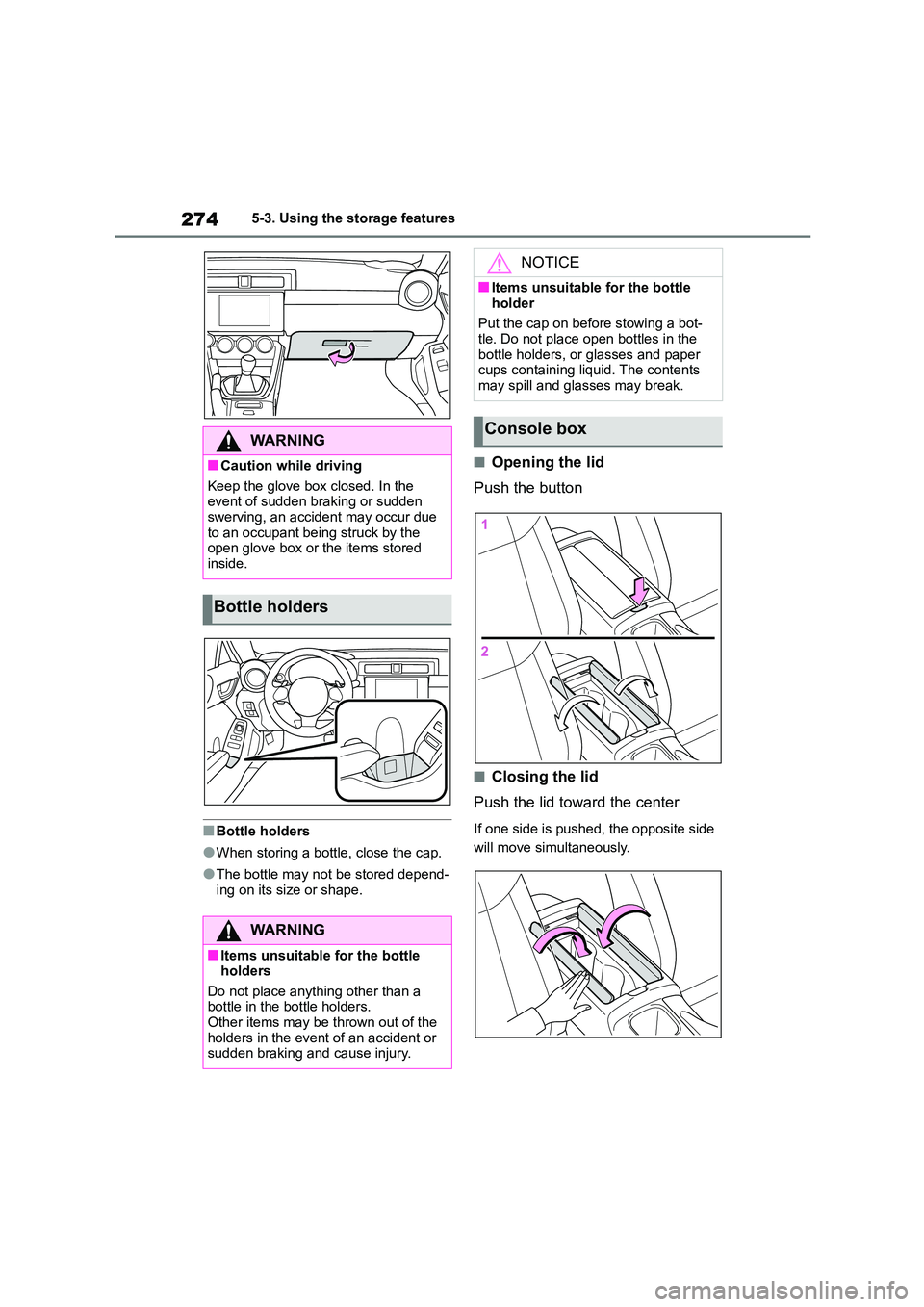
2745-3. Using the storage features
■Bottle holders
●When storing a bottle, close the cap.
●The bottle may not be stored depend- ing on its size or shape.
■Opening the lid
Push the button
■Closing the lid
Push the lid toward the center
If one side is pushed, the opposite side
will move simultaneously.
WA R N I N G
■Caution while driving
Keep the glove box closed. In the
event of sudden braking or sudden swerving, an accident may occur due
to an occupant being struck by the
open glove box or the items stored
inside.
Bottle holders
WA R N I N G
■Items unsuitable for the bottle
holders
Do not place anything other than a bottle in the bottle holders.
Other items may be thrown out of the
holders in the event of an accident or sudden braking and cause injury.
NOTICE
■Items unsuitable for the bottle
holder
Put the cap on before stowing a bot- tle. Do not place open bottles in the
bottle holders, or glasses and paper
cups containing liquid. The contents may spill and glasses may break.
Console box
Page 320 of 582
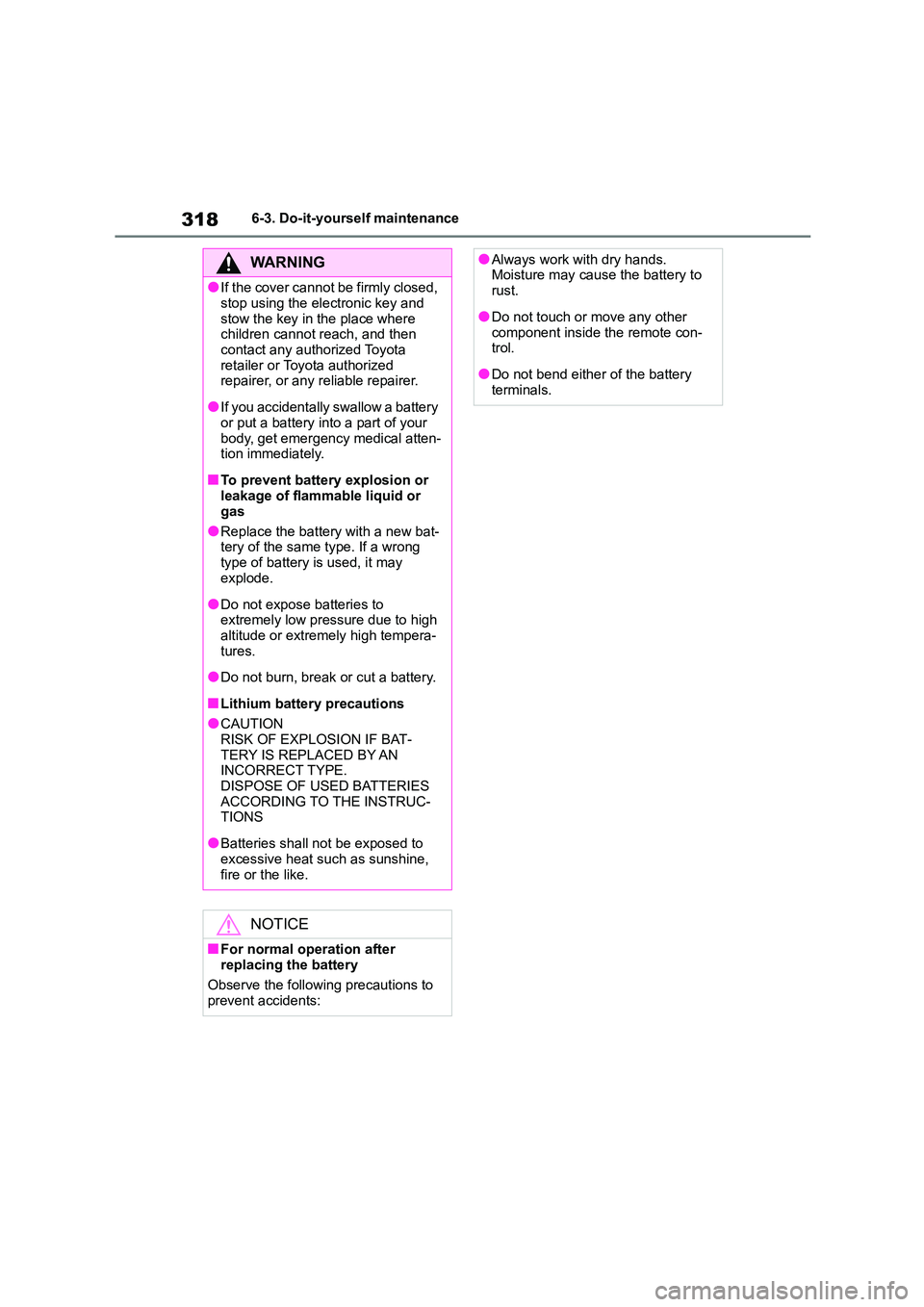
3186-3. Do-it-yourself maintenance
WA R N I N G
●If the cover cannot be firmly closed,
stop using the electronic key and
stow the key in the place where children cannot reach, and then
contact any authorized Toyota
retailer or Toyota authorized repairer, or any reliable repairer.
●If you accidentally swallow a battery
or put a battery into a part of your body, get emergency medical atten-
tion immediately.
■To prevent battery explosion or
leakage of flammable liquid or
gas
●Replace the battery with a new bat-
tery of the same type. If a wrong
type of battery is used, it may explode.
●Do not expose batteries to extremely low pressure due to high
altitude or extremely high tempera-
tures.
●Do not burn, break or cut a battery.
■Lithium battery precautions
●CAUTION
RISK OF EXPLOSION IF BAT- TERY IS REPLACED BY AN
INCORRECT TYPE.
DISPOSE OF USED BATTERIES ACCORDING TO THE INSTRUC-
TIONS
●Batteries shall not be exposed to
excessive heat such as sunshine,
fire or the like.
NOTICE
■For normal operation after replacing the battery
Observe the following precautions to
prevent accidents:
●Always work with dry hands. Moisture may cause the battery to
rust.
●Do not touch or move any other
component inside the remote con-
trol.
●Do not bend either of the battery
terminals.
Page 322 of 582
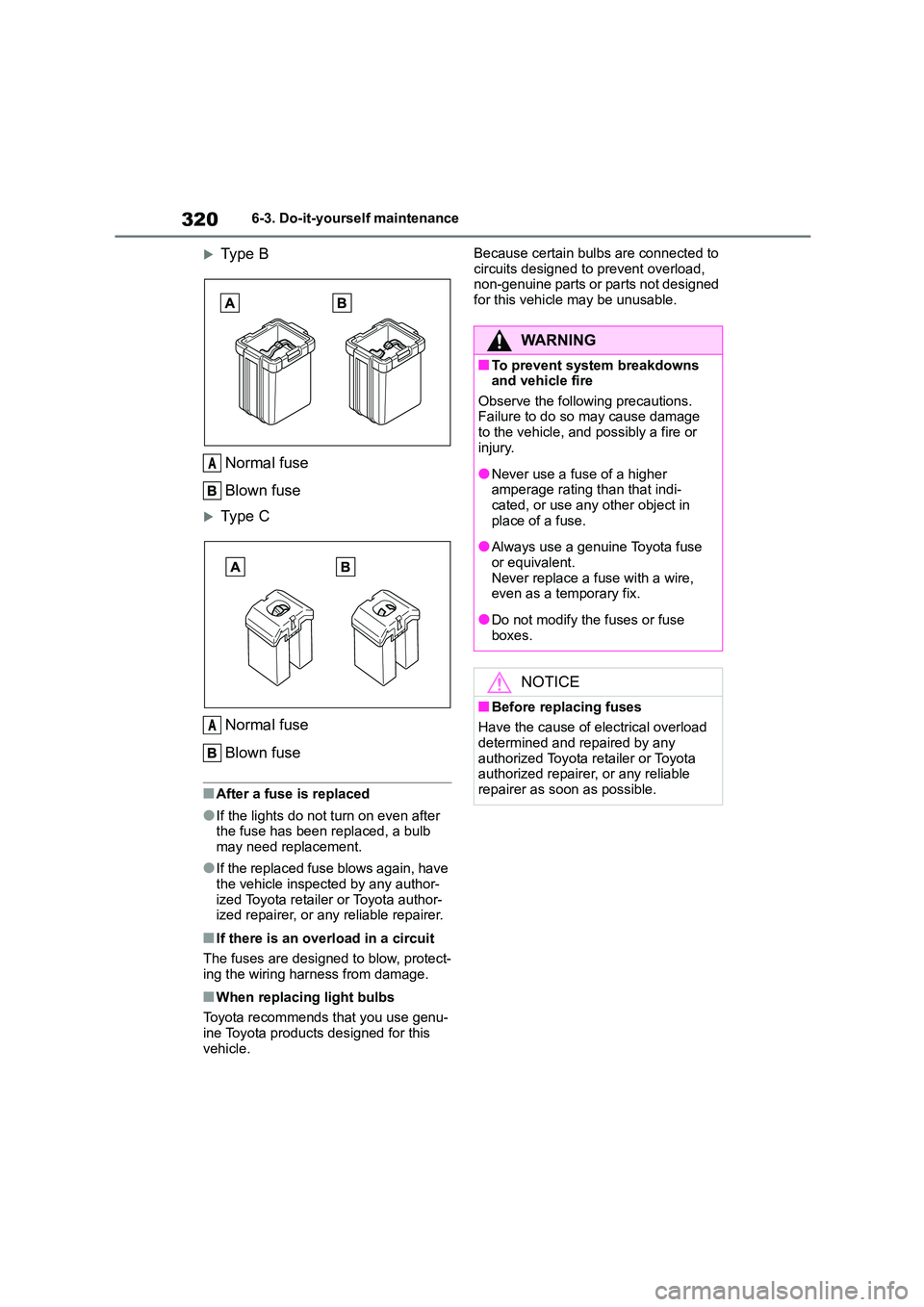
3206-3. Do-it-yourself maintenance
Type B
Normal fuse
Blown fuse
Type C
Normal fuse
Blown fuse
■After a fuse is replaced
●If the lights do not turn on even after
the fuse has been replaced, a bulb may need replacement.
●If the replaced fuse blows again, have the vehicle inspected by any author-
ized Toyota retailer or Toyota author-
ized repairer, or any reliable repairer.
■If there is an overload in a circuit
The fuses are designed to blow, protect-
ing the wiring harness from damage.
■When replacing light bulbs
Toyota recommends that you use genu- ine Toyota products designed for this
vehicle.
Because certain bulbs are connected to
circuits designed to prevent overload, non-genuine parts or parts not designed
for this vehicle may be unusable.
A
A
WA R N I N G
■To prevent system breakdowns and vehicle fire
Observe the following precautions.
Failure to do so may cause damage
to the vehicle, and possibly a fire or injury.
●Never use a fuse of a higher amperage rating than that indi-
cated, or use any other object in
place of a fuse.
●Always use a genuine Toyota fuse
or equivalent. Never replace a fuse with a wire,
even as a temporary fix.
●Do not modify the fuses or fuse
boxes.
NOTICE
■Before replacing fuses
Have the cause of electrical overload
determined and repaired by any
authorized Toyota retailer or Toyota authorized repairer, or any reliable
repairer as soon as possible.
Page 328 of 582
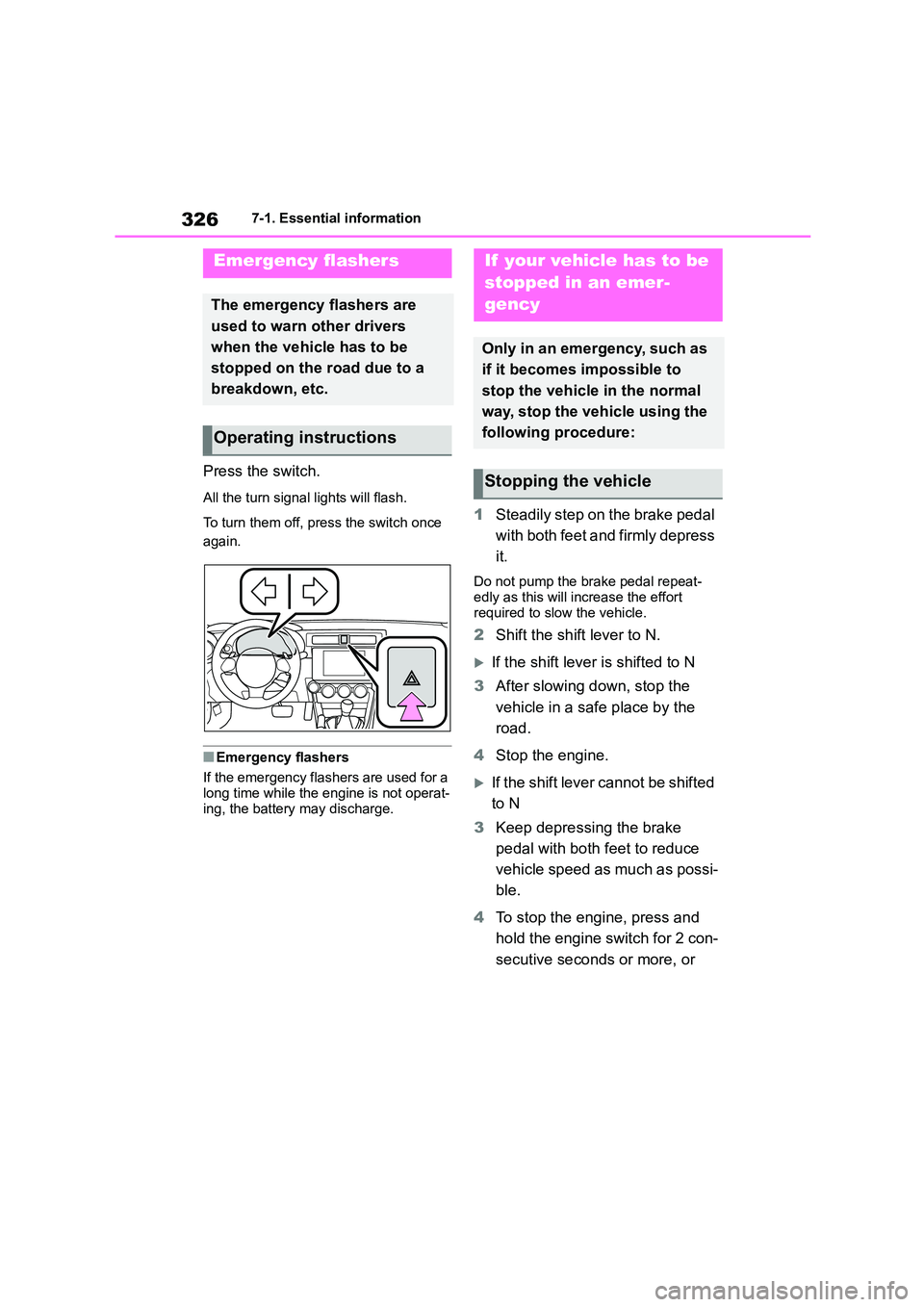
3267-1. Essential information
7-1.Essential information
Press the switch.
All the turn signal lights will flash.
To turn them off, press the switch once
again.
■Emergency flashers
If the emergency flashers are used for a long time while the engine is not operat-
ing, the battery may discharge.
1 Steadily step on the brake pedal
with both feet and firmly depress
it.
Do not pump the brake pedal repeat-
edly as this will increase the effort required to slow the vehicle.
2 Shift the shift lever to N.
If the shift lever is shifted to N
3 After slowing down, stop the
vehicle in a safe place by the
road.
4 Stop the engine.
If the shift lever cannot be shifted
to N
3 Keep depressing the brake
pedal with both feet to reduce
vehicle speed as much as possi-
ble.
4 To stop the engine, press and
hold the engine switch for 2 con-
secutive seconds or more, or
Emergency flashers
The emergency flashers are
used to warn other drivers
when the vehicle has to be
stopped on the road due to a
breakdown, etc.
Operating instructions
If your vehicle has to be
stopped in an emer-
gency
Only in an emergency, such as
if it becomes impossible to
stop the vehicle in the normal
way, stop the vehicle using the
following procedure:
Stopping the vehicle
Page 391 of 582
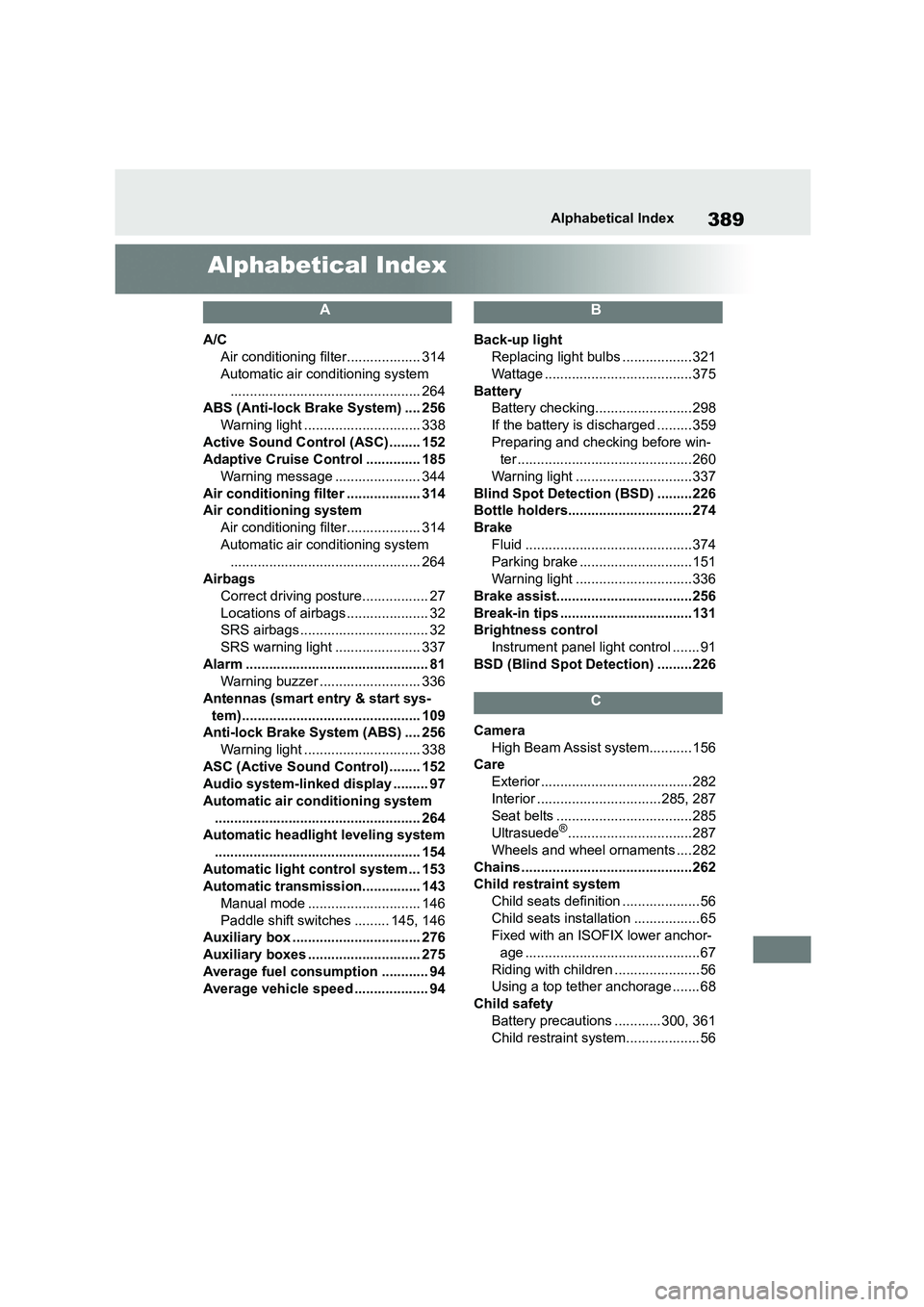
389Alphabetical Index
Alphabetical Index
A
A/C
Air conditioning filter................... 314
Automatic air conditioning system
................................................. 264
ABS (Anti-lock Brake System) .... 256
Warning light .............................. 338
Active Sound Control (ASC) ........ 152
Adaptive Cruise Control .............. 185
Warning message ...................... 344
Air conditioning filter ................... 314
Air conditioning system
Air conditioning filter................... 314
Automatic air conditioning system
................................................. 264
Airbags
Correct driving posture................. 27
Locations of airbags ..................... 32
SRS airbags ................................. 32
SRS warning light ...................... 337
Alarm ............................................... 81
Warning buzzer .......................... 336
Antennas (smart entry & start sys-
tem).............................................. 109
Anti-lock Brake System (ABS) .... 256
Warning light .............................. 338
ASC (Active Sound Control) ........ 152
Audio system-linked display ......... 97
Automatic air conditioning system
..................................................... 264
Automatic headlight leveling system
..................................................... 154
Automatic light control system ... 153
Automatic transmission............... 143
Manual mode ............................. 146
Paddle shift switches ......... 145, 146
Auxiliary box ................................. 276
Auxiliary boxes ............................. 275
Average fuel consumption ............ 94
Average vehicle speed ................... 94
B
Back-up light
Replacing light bulbs ..................321
Wattage ......................................375
Battery
Battery checking......................... 298
If the battery is discharged ......... 359
Preparing and checking before win-
ter ............................................. 260
Warning light ..............................337
Blind Spot Detection (BSD) .........226
Bottle holders................................274
Brake
Fluid ...........................................374
Parking brake .............................151
Warning light ..............................336
Brake assist...................................256
Break-in tips .................................. 131
Brightness control
Instrument panel light control ....... 91
BSD (Blind Spot Detection) .........226
C
Camera
High Beam Assist system........... 156
Care
Exterior ....................................... 282
Interior ................................285, 287
Seat belts ...................................285
Ultrasuede®................................287
Wheels and wheel ornaments .... 282
Chains ............................................262
Child restraint system
Child seats definition .................... 56
Child seats installation ................. 65
Fixed with an ISOFIX lower anchor-
age ............................................. 67
Riding with children ...................... 56
Using a top tether anchorage ....... 68
Child safety
Battery precautions ............ 300, 361
Child restraint system................... 56
Page 392 of 582
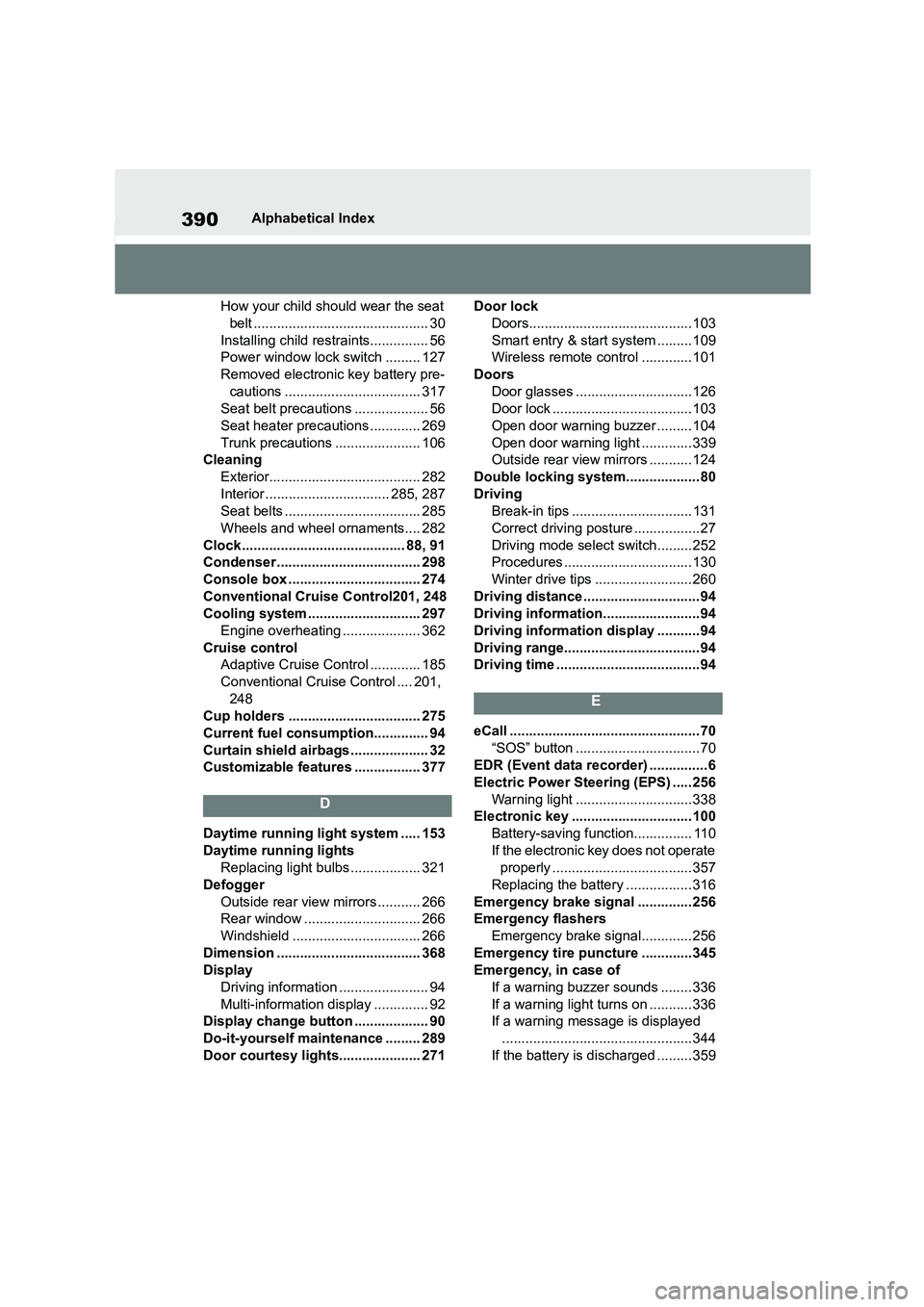
390Alphabetical Index
How your child should wear the seat
belt ............................................. 30
Installing child restraints............... 56
Power window lock switch ......... 127
Removed electronic key battery pre-
cautions ................................... 317
Seat belt precautions ................... 56
Seat heater precautions ............. 269
Trunk precautions ...................... 106
Cleaning
Exterior....................................... 282
Interior ................................ 285, 287
Seat belts ................................... 285
Wheels and wheel ornaments.... 282
Clock.......................................... 88, 91
Condenser..................................... 298
Console box .................................. 274
Conventional Cruise Control201, 248
Cooling system ............................. 297
Engine overheating .................... 362
Cruise control
Adaptive Cruise Control ............. 185
Conventional Cruise Control .... 201,
248
Cup holders .................................. 275
Current fuel consumption.............. 94
Curtain shield airbags .................... 32
Customizable features ................. 377
D
Daytime running light system ..... 153
Daytime running lights
Replacing light bulbs .................. 321
Defogger
Outside rear view mirrors ........... 266
Rear window .............................. 266
Windshield ................................. 266
Dimension ..................................... 368
Display
Driving information ....................... 94
Multi-information display .............. 92
Display change button ................... 90
Do-it-yourself maintenance ......... 289
Door courtesy lights..................... 271
Door lock
Doors.......................................... 103
Smart entry & start system .........109
Wireless remote control .............101
Doors
Door glasses ..............................126
Door lock .................................... 103
Open door warning buzzer ......... 104
Open door warning light ............. 339
Outside rear view mirrors ........... 124
Double locking system................... 80
Driving
Break-in tips ............................... 131
Correct driving posture ................. 27
Driving mode select switch.........252
Procedures ................................. 130
Winter drive tips ......................... 260
Driving distance .............................. 94
Driving information......................... 94
Driving information display ........... 94
Driving range................................... 94
Driving time ..................................... 94
E
eCall ................................................. 70
“SOS” button ................................ 70
EDR (Event data recorder) ............... 6
Electric Power Steer ing (EPS) ..... 256
Warning light ..............................338
Electronic key ............................... 100
Battery-saving function............... 110
If the electronic key does not operate
properly .................................... 357
Replacing the battery ................. 316
Emergency brake signal .............. 256
Emergency flashers
Emergency brake signal............. 256
Emergency tire puncture .............345
Emergency, in case of
If a warning buzzer sounds ........ 336
If a warning light turns on ........... 336
If a warning message is displayed
.................................................344
If the battery is discharged ......... 359